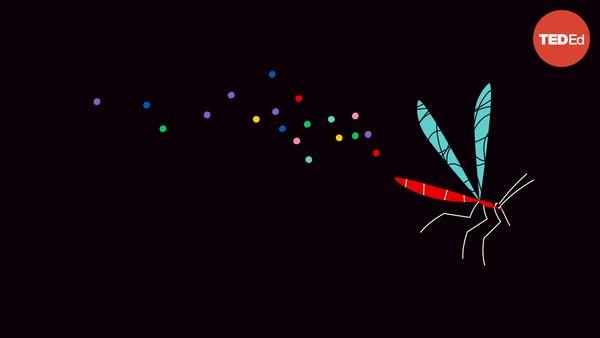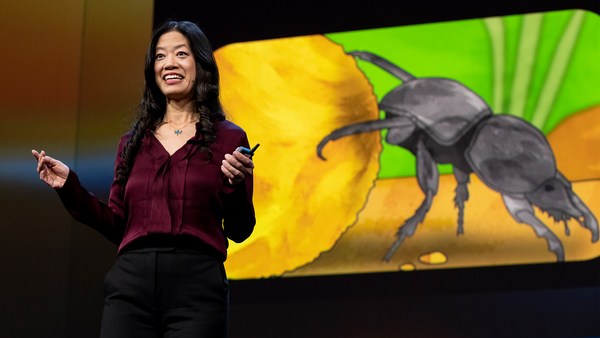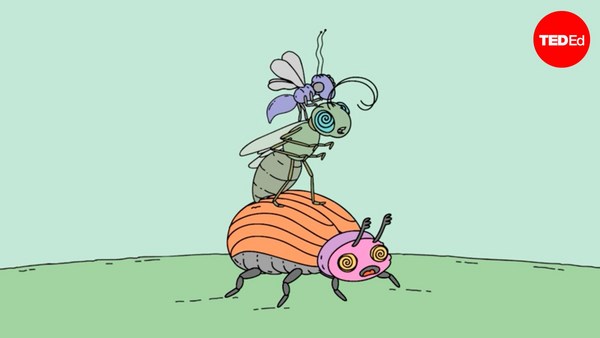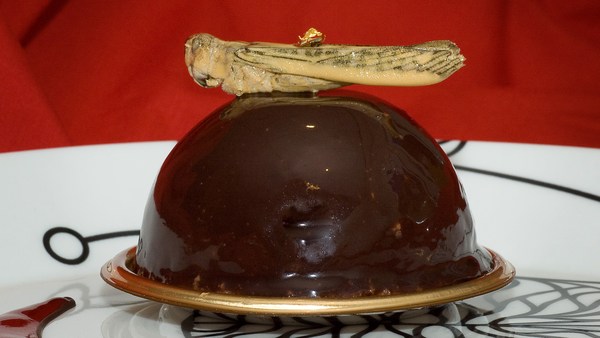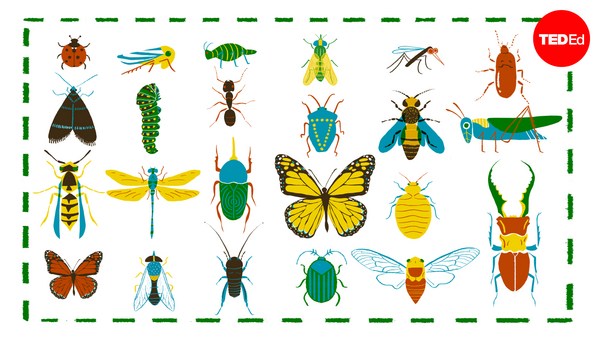I love bugs. I think of them as nature’s tiny engineers because they come up with the most extraordinary and incredible solutions to life’s problems. And I just love observing them because they're so full of surprises and curiosities.
During my career, I studied spiders that use their webs as a slingshot to capture prey deep in the Amazon rainforest, worms that tangle up with each other and form knots to form these shape-shifting blobs to survive in harsh environments such as sewers and caves, and tiny aquatic beetles that bring their own scuba gear when they dive, on their butts.
But today, I'm going to tell you a story about one of nature's most extraordinary engineers that pushes the limits of fluid mechanics and bioengineering and, arguably, solves their number one problem -- how insects pee.
A few years ago, my student, Elio Challita, and I observed this tiny insect having a private moment in our own backyards in Atlanta, and we couldn't believe our eyes. This insect was peeing for hours, and it was so quick we could barely see it. And we were blown away -- we had never seen anything like this. We had never seen an insect pee.
So today, I'm going to tell you how insects pee, why they pee so much and in this way, and finally, why you should care about insect pee.
(Laughter)
So sit back and relax -- you're in for a treat.
(Laughter and applause)
(Laughs) So one of the first things we had to discuss is "Wait a second -- insects pee?" And it turns out that almost all insects pee, in one form or another. It's a closed system -- what goes in must come out.
But the protagonist of today's story, Homalodisca vitripennis, or a glassy-winged sharpshooter -- isn't it gorgeous? You can see where it gets its name from, it's got these transparent wings. This insect specializes in feeding on xylem fluid from plants. It’s a sapsucker. But I think of it as a plant's mosquito. And just after a mosquito sucks your blood, it leaves behind a parting gift -- so do these sharpshooters that spread bacteria into these plants, and it causes devastating and deadly diseases in plants, killing them. This is a huge problem in agriculture, including here in California, where it caused millions of dollars in damage to vineyards.
And you can appreciate what they lack in size, they make up in numbers. This is what millions of insects feeding and peeing looks like. If only this woman knew where that water was coming from.
(Laughter)
Now, don't worry, this insect's pee is just water. And so for the first time, I'm going to show you this behavior, slowed down with our high-speed cameras, and this is what we discovered. We realized that this insect forms a droplet of pee, and then it flings them at extreme accelerations, of 40 g-forces. That's 40 times faster than the sprint of a cheetah. These insects are really packing a punch from their butts.
And we wanted to under-- (Laughs) We wanted to take a closer look at this flicker, so we put this insect and took a look under a microscope at its business end, and this beautiful structure has a scientific name: it's called a butt flicker.
(Laughter)
And this is what we discovered. We realized that this insect had evolved springs and latches, just like a catapult, so that it could efficiently hurl its droplets of pee, repeatedly, at these high accelerations.
Now, we wanted to measure the speed at which this flicker was moving, and the droplets, so we measured the speed of both the droplets and the flicker. And this is where we made a puzzling observation. The speed of the droplets in the air was faster than the flicker. So if you take a ratio of that, we were expecting it to be 100 percent, but turns out that the speed of the droplets are about 150 to 200 [percent] faster than the flicker itself.
This is why this is counterintuitive: imagine a Yankees baseball player throwing a ball at 100 miles an hour. At some point during that throw, their hands and fingers are moving at 100 miles an hour. Say an amateur ballplayer throws a ball at 50 miles an hour, and if you measure the speed of the ball and it's 100 miles an hour in midair, we’d be surprised -- where would that extra speed come from, right? This is exactly what these insects are doing.
So to solve this puzzle, we went back and looked at our videos. And we’ll play this a couple of times -- see if you can figure this out.
Did you catch it? Let me grab a frame.
We realized that unlike a baseball that’s rigid ... due to surface tension, these tiny droplets are squishy, and we had an “aha” moment. We were wondering if this insect is storing energy due to the surface tension just before launch. And to test this, we did, naturally, what any of us would do -- we converted our kitchen tables into a lab to test this.
So now, we're going to place droplets on a speaker, to squish them at high speeds, and this is what we discovered. We realized that water that flows in our faucets like a liquid, at these tiny scales, due to surface tension, with the right timing, can get a kick, store energy, and if you time it just right, you can launch these off at extremely high speeds, just like a child on a trampoline. And to test this idea of timing, we even built a catapult. Our should I say a "cata-pee"?
(Laughter)
And it reinforced this idea: too slow, the droplets don’t go off, and then if you move at the right speed, you've flung this.
So I've told you today how these insects use this catapulting structure to store energy and surface tension and throw these droplets at record-breaking speeds to be, really, number one ... at number one. (Laughs) But why have these insects evolved this remarkable ability? And there are two reasons for this.
Number one is they are on a zero-calorie diet. These tiny bugs are feeding from the xylem fluid that comes up through the roots, through the soil, and goes to the rest of the plant. It's very, very poor in nutrients -- it's just water and some minerals. This is unlike the phloem fluid, which is rich in sugar, coming through photosynthesis at the leaves and going through the rest of the plant. This is akin to a human purely sustaining themselves on a diet of diet lemonade. Very low energy source -- you'd have to constantly drink, but you'd have to constantly pee as well.
This still doesn't explain why these insects pee in droplets, and not in jets, like you and I would, if you were to take a bio break. Let's take a look at cicadas. These are the cousins of these sharpshooters. They're also xylem fluid feeders ... and they pee in jets.
(Laughter)
I love this video. This shows cicadas doing two of their favorite things when they come out of hibernation -- singing at the top of their lungs and peeing in the wind.
(Laughter)
And the second reason why these insects pee in droplets is size -- these things are tiny, they're smaller than my pinky. In fact, the surface tension that enables them to store energy in these droplets to launch is actually an impediment, because gravity doesn't matter, and surface tension sticks these droplets to their bodies. So they actually have to flick these droplets away -- it's actually very difficult for these tiny bugs to pee. And that's why I just love studying bugs.
This tiny engineer has figured out how to survive on barely just water through the xylem fluid. And it’s figured out to do so, it has to drink a lot, and pee a lot. In that sense, it's not so different from other engineers I know on a Friday night at a bar.
(Laughter)
But to do so, it’s figured out it had to evolve this catapulting structure and fling these droplets at high speeds. And that’s why I always tell my students when we explore new bugs, "It's not a bug, it's a feature."
(Laughter)
(Applause)
OK, so why should you care about insect pee, and what’s the practical application of this work? Maybe, maybe one day, these ideas, these principles could help us design more efficient water-ejector systems for our smartphones, our watches and hearing aids.
But I have to be honest, that's not really why I've obsessed over insect pee for the last four years. I do this because when I share my work with kids, it ignites their curiosity. When I talk about insect pee, it makes their eyes light up. They laugh, they run around in their backyards, looking at bugs and asking questions. It reminds them and us that we can discover marvelous in the mundane, even in our own backyards. We just have to look closely.
Thank you so much.
(Cheers and applause)
I've got to go pee.
